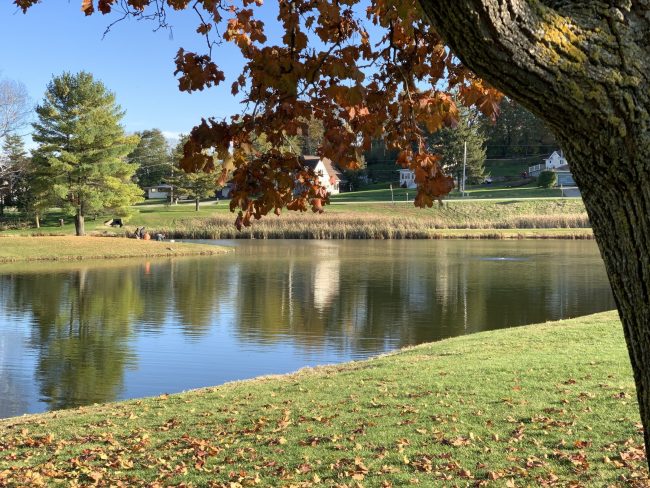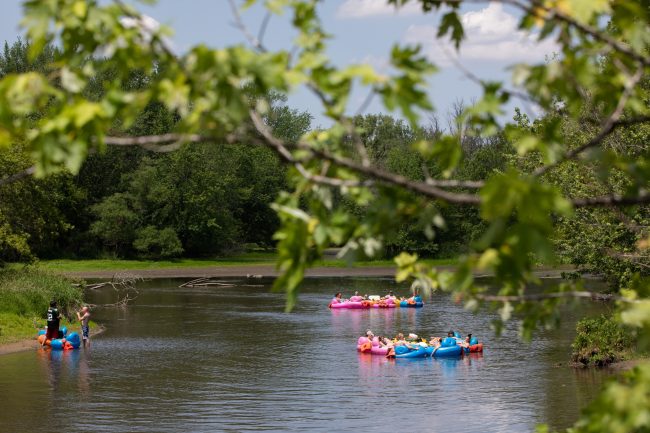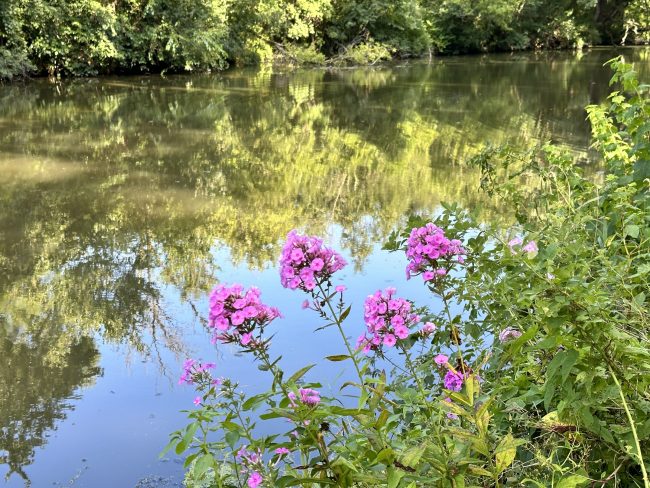Surface Water & Watershed Management

Surface Water & Watershed Management
About
Surface Water
What is Surface Water?
Surface water includes any water that falls as precipitation, including snowmelt, and flows over the ground. While all water that runs over or pools on top of the ground qualifies as such, generally when we talk about surface water, we’re referring to streams, rivers, lakes, and wetlands. Southwestern Wisconsin is blessed with abundant surface water resources, especially streams and rivers, which support a wide variety of aquatic and terrestrial plants and animals that depend on surface water. The Wisconsin Department of Natural Resources (WDNR) estimates there are 88,000 miles of streams and rivers in the state.
Some portion of surface water becomes groundwater when it soaks into the ground, and groundwater, in turn, can become surface water again if it seeps out of the ground as a spring or into a stream or river channel. As a result, the quality and quantity of groundwater and surface water is closely related.

Surface Water Quality

Southwester Wisconsin Surface Water Quality
It’s difficult to make generalized statements about surface water quality across the region for several reasons. First, the Wisconsin Department of Natural Resources (WDNR) is responsible for monitoring and reporting on surface and groundwater quality in the state and they have limited resources to fulfill that obligation. Therefore, they have to prioritize where they will conduct that monitoring each year and many rivers, streams, and lakes do not get monitored for many years. Also, the methodology that WDNR uses for assessing the health of our surface waters is complex and multi-faceted. For example, they use one set of criteria to determine if a water body is safe for recreation and different criteria to determine if a water body is supporting healthy communities of fish and other aquatic life.
Nevertheless, it is possible to state that, overall, surface water quality has improved significantly in SW Wisconsin over the past 50 years, due in large part to regulations that have resulted in a significant reduction in pollutants being released from wastewater treatment plants and industries and also due to improvements in farming practices that have reduced soil erosion and runoff of fertilizers, pesticides, and manure from livestock operations, dairies, and cropland. Statewide, in 2018, WDNR reported that 82% of all surface water bodies that were assessed were healthy and 18% were impaired for recreation, aquatic life, or fish consumption.
However, much remains to be done to further reduce soil erosion, pollutant runoff, and to restore habitat that supports aquatic life.

Causes of Surface Water Quality Impairments
The most common cause for a surface water body to be designated as impaired by WNDR is high concentrations of phosphorus. Phosphorus occurs naturally in soils and surface water, but high concentrations typically are caused by runoff of phosphorus from farmland, where it is applied to cropland and pasture as chemical fertilizer or as a component of manure. Phosphorus can also come from wastewater treatment plant discharges to rivers and streams. High phosphorus and other plant nutrients, like nitrogen, can cause excess algae growth in rivers and lakes. Nitrates, a form of Nitrogen that is easily dissolved in water, are also a health hazard to humans at concentrations above 10 milligrams per liter. Other causes of surface water impairment are mercury, polychlorinated biphenyls (PCBs), sediment (caused by soil erosion), and bacteria from human and animal waste. Surface waters can also be impaired by channelization, which occurs when the natural course or shape of a river or stream is altered in order to accommodate some land use. For example, many rivers and streams were dammed in the past to pool water for industry or recreation and many streams have also been straightened and widened to make flood-prone areas more suitable for development and agriculture. Altering stream channels can also remove critical habitat for fish and other aquatic life.

Improving Surface Water Quality
Much progress has been made to improve the quality of surface water around the United States since passage of the federal Clean Water Act in 1972. Pollutants from industries and wastewater treatment plants, in particular, have been greatly reduced since the 1960’s. However, much work still remains to be done to reduce the impacts of land use on water quality. In most urban areas, local governments are required to demonstrate that they are taking steps to prevent contaminants from running off lawns, streets, and other paved surfaces into storm sewers, rivers, and streams. In agricultural areas, farmers and landowners are encouraged to adopt best management practices (BMPs) that reduce soil erosion and runoff of fertilizers, pesticides, and manure into drainage channels, rivers, and streams. While most BMPs are voluntary, over the past 20 years, the federal government and State of Wisconsin have adopted some regulations that require certain practices to reduce the risk of manure and agricultural chemicals like fertilizers from leaving the farm and contaminating surface water.
Surface Water Resources
For more information about surface water, including quality, standards, reports, and more, see the resources in the dropdown menu below!
Surface Water Resources
A great deal of information can be accessed from the Wisconsin Department of Natural Resources’ Surface Water website page, including information about Wisconsin’s water quality standards, water quality reports, and WDNR programs aimed at assessing and protecting surface water quality and habitat.
The Wisconsin Department of Natural Resources Surface Water Data Viewer webpage is an online tool for accessing and viewing water quality data collected across the state of Wisconsin.
PDF files of the State of Wisconsin’s bi-annual Water Quality Report to Congress webpage can be downloaded from the WDNR website.
Wisconsin Surface Water Data Viewer
The Wisconsin Surface Water Data Viewer website is a data delivery system that provide interactive web mapping tools for a wide variety of datasets including chemistry (water, sediment), physical, and biological (fish, etc) data.
Additional Information
Contact Tonya Gratz with the Green County Land and Water Conservation Department website for more information regarding surface water in Green County. Tonya can be reached at tonya.gratz@wi.nacdnet.net or 608-325-4195.
About
Watersheds
What is a Watershed?
Water flows downhill and as it flows downhill it gathers into small streams and, eventually, rivers. All the land that collects water that flows into a stream or lake is referred to as the watershed for that lake or stream. As you might expect, small streams have small watersheds and large rivers, like the Wisconsin River have very large watersheds. The large watersheds can be subdivided into many small watersheds (sometimes referred to as sub-watersheds) in the same way that a county can be sub-divided into townships. Watersheds are important because what happens on the land that drains into our rivers and streams and lakes greatly affects the quality of the water in those surface water bodies.
Watershed management is an approach to managing water quality in our rivers, streams, lakes and reservoirs by looking at land use throughout the watershed and identifying ways to manage the land in ways that minimizes the impact on water quality. For example, in urban areas, watershed management might involve looking for ways to reduce pollutant runoff from paved surfaces and fertilizer runoff from lawns. In agricultural areas, watershed management might involve looking for ways to reduce soil erosion and manure runoff from cropland and pastures. Governments, organizations, and individuals have to work together for watershed management to be effective because many different individuals and entities are involved in making land use decisions.

Watershed Resources
See the dropdown menu below to view and access more resources for learning about watersheds, watershed management, and farmer-led watershed councils!
Watershed Resuorces
- WDNR’s Gateway to Wisconsin’s basins and watersheds website provides an interactive map of Wisconsin’s major watersheds (also called ‘basins’). Click on your basin to learn more about watersheds and water quality in your area.
- Learn more about Producer-Led (farmer-led) Watershed Councils webpage funded by the Department of Agriculture, Trade and Consumer Protection.
- Learn more about the Lafayette Ag Stewardship Alliance webpage farmer-led watershed council in Lafayette County.
- Learn more about the Iowa County Uplands webpage farmer-led watershed group.
- Learn more about Farmers of the Sugar River webpage watershed group in Green, Rock, and Dane Counties.
Questions? Contact:
- Jordyn Sattler, Regional Crops and Soils Educator, at (608) 328-9440 or jordyn.sattler@wisc.edu.




